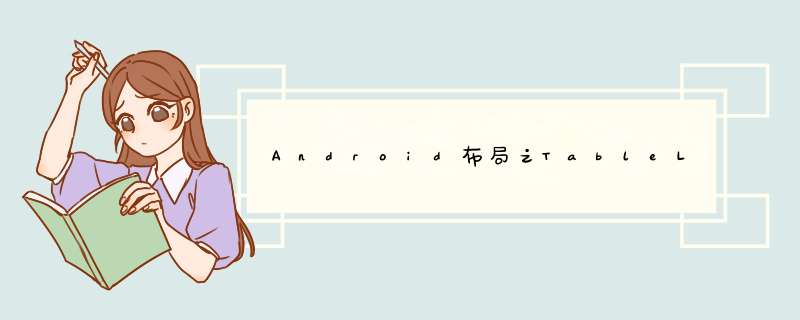
tablelayout类以行和列的形式对控件进行管理,每一行为一个tableRow对象,或一个VIEw控件。当为tableRow对象时,可在tableRow下添加子控件,默认情况下,每个子控件占据一列。 当为VIEw时,该VIEw将独占一行。
三个常用的属性
androID:collapseColumns:设置需要被隐藏的列的序号
androID:shrinkColumns:设置允许被收缩的列的列序号
androID:stretchColumns:设置运行被拉伸的列的列序号
学习导图
(1)tableLayout的相关简介
java的swing编程和HTML中经常会使用到表格,可见表格的应用开发中使用还是比较多的,同样androID也为我们提供这样的布局方式。
(2)如何确定行数
a:直接向tableLayout组件,直接占一行
b:如果想在一行添加多个组件, 就需要使用tableRow中添加
c:tableRow中有多少个组件,这一行就会有多少列
(3)三个常用属性(都是从零开始计数)
Shrinkable:如果某一列被设置为Shrinkable,那么该列的所有单元格的宽度可以被收缩,以保证表格能适应父容器的宽度;
Stretchable:如果某一列被设置为Stretchable,那么该列的所有单元格的宽度可以拉伸,以保证组件完全填充表格空余空间;
Collapsed:如果某一列被设置为Collapsed,那么该列的所有单元格的都会被隐藏;
(4)使用实例(为了演示效果没有,所有组件都没有设置ID)
<?xml version="1.0" enCoding="utf-8"?><linearLayout xmlns:androID="http://schemas.androID.com/apk/res/androID" androID:layout_wIDth="match_parent" androID:layout_height="match_parent" androID:orIEntation="vertical"> <!--定义第一个表格布局,指定第二列允许收缩,第三列拉伸--> <tableLayout androID:layout_wIDth="match_parent" androID:layout_height="wrap_content" androID:shrinkColumns="1" androID:stretchColumns="2"> <!-- 直接添加组件会独占一行--> <button androID:layout_wIDth="wrap_content" androID:layout_height="wrap_content" androID:text="独自占一行" /> <tableRow> <button androID:layout_wIDth="wrap_content" androID:layout_height="wrap_content" androID:text="普通按钮"/> <button androID:layout_wIDth="wrap_content" androID:layout_height="wrap_content" androID:text="收缩按钮"/> <button androID:layout_wIDth="wrap_content" androID:layout_height="wrap_content" androID:text="拉伸按钮"/> </tableRow> </tableLayout> <!--定义第二个表格布局指定第二列隐藏--> <tableLayout androID:layout_wIDth="match_parent" androID:layout_height="wrap_content" androID:collapseColumns="1"> <!-- 直接添加组件会独占一行--> <button androID:layout_wIDth="wrap_content" androID:layout_height="wrap_content" androID:text="独自占一行" /> <tableRow> <button androID:layout_wIDth="wrap_content" androID:layout_height="wrap_content" androID:text="普通按钮"/> <button androID:layout_wIDth="wrap_content" androID:layout_height="wrap_content" androID:text="普通按钮"/> <button androID:layout_wIDth="wrap_content" androID:layout_height="wrap_content" androID:text="普通按钮"/> </tableRow> </tableLayout> <!--定义第三个表格布局,指定第二列,第三列都可以被拉伸--> <tableLayout androID:layout_wIDth="match_parent" androID:layout_height="wrap_content" androID:stretchColumns="1,2"> <!-- 直接添加组件会独占一行--> <button androID:layout_wIDth="wrap_content" androID:layout_height="wrap_content" androID:text="独自占一行" /> <tableRow> <button androID:layout_wIDth="wrap_content" androID:layout_height="wrap_content" androID:text="普通按钮"/> <button androID:layout_wIDth="wrap_content" androID:layout_height="wrap_content" androID:text="拉伸按钮"/> <button androID:layout_wIDth="wrap_content" androID:layout_height="wrap_content" androID:text="拉伸按钮"/> </tableRow> </tableLayout></linearLayout>
以上内容是小编给大家介绍的androID布局之tableLayout表格布局,希望大家喜欢。
总结以上是内存溢出为你收集整理的Android布局之TableLayout表格布局全部内容,希望文章能够帮你解决Android布局之TableLayout表格布局所遇到的程序开发问题。
如果觉得内存溢出网站内容还不错,欢迎将内存溢出网站推荐给程序员好友。
欢迎分享,转载请注明来源:内存溢出

 微信扫一扫
微信扫一扫
 支付宝扫一扫
支付宝扫一扫
评论列表(0条)